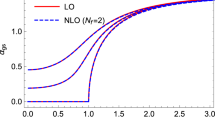Abstract
Using a three- and four-dimensional Pauli–Villars regularization scheme, we investigate quark–antiquark and diquark condensation in the framework of the Nambu–Jona-Lasinio model. Using the particle Fermi momentum as a cutoff parameter, we study the energy gap width and coherence length for the meson condensate 〈\(q\bar q\) 〉. We also study the energy gap width and critical coherence length (the distance over which there would be no diquark condensation) for the diquark 〈qq〉 and the dependence on the Fermi momentum. We obtain an estimate of the Fermi momentum value for meson and diquark condensates with an energy gap width of the order of 100 MeV.
Similar content being viewed by others
References
Y. Nambu and G. Jona-Lasinio, “Dynamical model of elementary particles based on an analogy with superconductivity: II,” Phys. Rev., 124, 246–254 (1961).
X.-Y. Guo, X.-L. Chen, and W.-Z. Deng, “Heavy mesons in the Nambu–Jona-Lasinio model,” Chin. Phys. C, 37, 033102 (2013).
Y. Jiang, K. Ren, T. Xia, and P. Zhuang, “Meson screening mass in astrongly coupled pion superfluid,” Eur. Phys. J. C, 71, 1822 (2011).
T. Inagaki, D. Kimura, H. Kohyama, and A. Kvinikhidze, “Nonet meson properties in the Nambu–Jona-Lasinio model with dimensional versus cutoff regularization,” Phys. Rev. D, 83, 034005 (2011); Erratum, 83, 039905 (2011).
U. Vogl and W. Weise, “The Nambu and Jona-Lasinio model: Its implications for hadrons and nuclei,” Prog. Part. Nucl. Phys., 27, 195–272 (1991).
D. Ebert, A. N. Ivanov, and M. K. Volkov, “Mesons in the quark model of superconductivity type,” Fortsch. Phys., 37, 487–540 (1989).
S. Hands and D. N. Walters, “Evidence for BCS diquark condensation in the 3+1d lattice NJL model,” Phys. Lett. B, 548, 196–203 (2002).
D. Ebert, K. G. Klimenko, and V. L. Yudichev, “Pion, σ meson, and diquarks in the two-flavor colorsuperconducting phase of dense cold quark matter,” Phys. Rev. C, 72, 015201 (2005).
K. G. Klimenko and D. Ebert, “Mesons and diquarks in a dense quark medium with color superconductivity,” Theor. Math. Phys., 150, 82–96 (2007).
D. Ebert, K. G. Klimenko, and V. L. Yudichev, “Mesons and diquarks in neutral color superconducting quark matter with β equilibrium,” Phys. Rev. D, 75, 025024 (2007).
G. Hellstern, R. Alkofer, and H. Reinhardt, “Diquark confinement in an extended NJL model,” Nucl. Phys. A, 625, 697–712 (1997).
H. Mineo, J. A. Tjon, K. Tsushima, and S. N. Yang, “Faddeev calculation of the pentaquark θ + in the Nambu–Jona-Lasinio model-based diquark picture,” Phys. Rev. D, 77, 055203 (2008).
S. V. Molodtsov and G. M. Zinovjev, “Diquark condensate and quark interaction with instanton liquid,” Phys. Atom. Nucl., 66, 1349–1356 (2003); arXiv:hep-ph/0112075v1 (2001).
K. Kawashima, “Infrared behavior of the attractive di-quark channel in the QCD model,” Internat. J. Modern Phys. A, 25, 2023–2035 (2010).
T. Brauner, “Details on fitting parameters in the two-flavour NJL model in various regularization schemes,” https://sites.google.com/site/braunercz/notes (undated).
D. Ebert, T. Feldmann, R. Friedrich, and H. Reinhardt, “Effective meson lagrangian with chiral and heavy quark symmetries from quark flavor dynamics,” Nucl. Phys. B, 434, 619–646 (1995).
L. Paulucci, E. J. Ferrer, J. E. Horvath, and V. de la Incera, “Bag versus NJL models for colour–flavour-locked strange quark matter,” J. Phys. G: Nucl. Part. Phys., 40, 125202 (2013).
B. O. Kerbikov, “Color superconducting state of quarks,” arXiv:hep-ph/0110197v1 (2001).
M. N. Chernodub, “Vacuum superconductivity, conventional superconductivity, and Schwinger pair production,” Internat. J. Mod. Phys. A, 27, 1260003 (2012).
M. Matsuzaki, “Spatial structure of quark Cooper pairs in a color superconductor,” Phys. Rev. D, 62, 017501 (2000).
H. Abuki, T. Hatsuda, and K. Itakura, “Structural change of Cooper pairs and momentum-dependent gap in color superconductivity,” Phys. Rev. D, 65, 074014 (2002).
G. S. Bali, Ch. Schlichter, and K. Schilling, “A Ginzburg–Landau analysis of the colour electric flux tube,” Nucl. Phys. Proc. Suppl., 73, 638–640 (1998).
B. O. Kerbikov, “BCS–bose crossover in color superconductivity,” Phys. Atom. Nucl., 65, 1918–1920 (2002).
H. Kiuchi, “The effect of lattice-QCD-based gluon propagator on coherence length of quark cooper pairs in two-flavor color superconductor,” J. Phys. Stud., 11, 390–395 (2007).
T. Schäfer, “Diquark condensation in high density baryon matter,” Nucl. Phys. A, 642, c45–c50 (1998).
D. S. Hwang, “Decay constants and semileptonic decays of heavy mesons in the relativistic quark model,” Phys. Rev. D, 53, 4951–4956 (1996).
S. Pepin, M. C. Birse, J. A. McGovern, and N. R. Walet, “Nucleons or diquarks: Competition between clustering and color superconductivity in quark matter,” Phys. Rev. C, 61, 055209 (2000).
Author information
Authors and Affiliations
Corresponding author
Additional information
The authors thank the University Grants Commission, Government of India, for the financial support.
Prepared from an English manuscript submitted by the authors; for the Russian version, see Teoreticheskaya i Matematicheskaya Fizika, Vol. 190, No. 1, pp. 104–111, January, 2017.
Rights and permissions
About this article
Cite this article
Ghosh, R., Bhattacharya, A. & Chakrabarti, B. A study of diquark and meson condensation in the Nambu–Jona-Lasinio model and Fermi momentum. Theor Math Phys 190, 91–97 (2017). https://doi.org/10.1134/S004057791701007X
Received:
Revised:
Published:
Issue Date:
DOI: https://doi.org/10.1134/S004057791701007X




